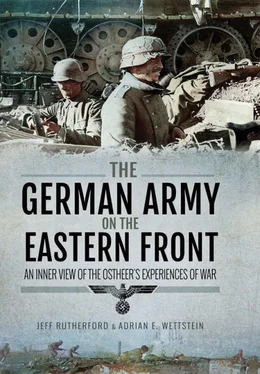4) Commissars and red officers are the best trophies. You can recognize them by the binoculars, the map pouch and special behaviour.
5) Lurk for the imprudent observer behind embrasured emplacements, on deploying enemy weapons, on vehicles, in cars; the latter often follow the same paths.
6) Again and again, let observation posts and other sniper comrades call your attention to worthwhile goals. Examine the observation books and, above all, inform the observation posts about all your discoveries.
7) Look for favourable positions to shoot, apart from other comrades. Often you will find a favourable fire position behind the front trench in covered places.
8) Camouflage yourself well. With snow, wear a white headcap, white gloves, and paint your gun white.
9) Always ensure that you have a firm rifle base. For this purpose, always carry a specially cut fork with you.
10) Never fire more shots from the same spot, otherwise you will be subject to counter-fire. Watch carefully before the shot and immediately afterwards change place.
11) Always remember that if you and your sniper comrades shoot only one Bolshevik daily, in a month with 4 snipers in the Grenadier Company, your regiment will face 1,080 fewer Russians.
12) Read this leaflet again and again until you know it by heart and act and follow it in the trench – to the best of your comrades.
The language which equated sniping with hunting, thereby relegating Soviet soldiers to game, is noticeable. From a tactical point of view, the focus on Soviet leadership was clearly important. German reports from the east often mentioned the decline of fighting power in Soviet units after the loss of their leaders and especially after the loss of the commissars. While this is difficult to prove or refute, this was the German perception and it guided many German measures. Also highlighted in the leaflet was the pride of arms of snipers, as well as the care for weapons. While this was (and still is) an important issue for snipers, under the extremely demanding circumstances of the Eastern front, maintenance of weapons was even more important. Finally, the integration of snipers into the intelligence gathering network (point 6) was a very progressive concept.
Due to changing conditions, the use of German armoured units also had to adapt. After Operation Citadel, German armoured troops were rarely used in an operational manner; rather, they were most often employed in counter-strikes at Soviet breakthroughs. The divisions suffered heavily in men and material from being thrown from one crisis to the next with only minor breaks between fighting and movement, and they rarely approached anything comparable to divisional strength. Furthermore, the often hasty manner of the counter-strikes did not allow for full assembly of the units, so most attacks were conducted by battlegroups that although called divisions, often had the strength of a mere regiment. This, as well as Soviet tactical progress in intercepting German armoured attacks, i.e. by the already mentioned ATG fronts, forced the German army to adapt in its use of armoured units. The next source, a widely circulated experience report by XXXXVIIIth Panzer corps about its deployment in the Ukrainian fighting of late 1943/early 1944 – an especially grim one thus far under-researched – provides evidence of the evolution of German armoured operations: [24]
The corps has always fought at the decisive point in the attack and on the defensive. A various number of army and Waffen-SS Panzer divisions and infantry divisions were subordinated to it.
1) Infantry divisions in the present form are no longer up to date. The assignment of an assault gun battalion can fundamentally remedy this ill and at one stroke make our infantry fully fit for action again. The light machine gun with its accessories is too heavy. The infantry is so scattered in all directions in today’s Panzer war, that it will throw away its machine gun equipment due to physical exhaustion after a short time. Experiments with the new machine carbine (submachine gun 43) must seek the removal of the light machine gun. Towed anti-tank guns break down for the same reasons. The infantry requires self-propelled anti-tank guns. Close combat anti- tank weapons of the ‘ Faustpatrone ’ [fist cartridge] type are required by every group. As a result of what was mentioned above, the structure of the infantry and motorized riflemen companies is as follows: 2 assault platoons with 3 groups each, group around 1/7. [25]Weapons: 5 machine carbine rifle men, 2 men with pistols, Faustpatrone and hand grenades. 1 heavy platoon, 2 heavy machine guns, 2 heavy mortars, 3 Ofenrohr [bazookas] […]
3) Panzer divisions proven. Our tanks are absolutely materially superior to the Russian. Training: The corps owes a great part of its successes to the use of the night, to the ruthless continuation of the attack by moonlight. The troops had to become accustomed to this kind of fighting. In particular, newly formed tanks units and army tank battalions believe that the tank is not be used by night and brusquely refuse its commitment by night. Training must remedy that. The Russian uses his tanks with full light (strong spotlights with blinding effects) against our retreating columns by night with good success. The training of all soldiers in the mine war that I demanded earlier has to be put into effect. […] Unfortunately, the decree of the General of the Engineers of 20 December 1943 for the relevant training and use of mines also includes too many obstructions. The low number of Russian tanks destroyed by and through mines may have the same cause. Losses through our own mines must be accepted by the troops, as well as losses through other [of our own] arms. The Russian throws entire ATG regiments and brigades against our tank attacks. The breaking of such ATG lines has proved especially difficult. Partly, the troops shrank from it more than tank combat. The use of terrain, night attack and above all the cooperation of all weapons, particularly the timely and skilled use of artillery, lead to success. Also the use of air force (tank hunters) was quite successful.
4) Blocking units. The German side could for the most part only throw alarm units against Russian tank formations that rapidly penetrated in depth. Their combat value was low. Following the Russian example (see above), ATG regiments seem necessary. To prevent the German addiction to over-organization and the therewith connected wastage of personal and material, it is recommended to take the Russian combat strength table [26]as a basis. The units can then win on handiness and agility. As a weapon for those units, there would only towed ATGs. Self-propelled guns don’t have any operational mobility and [suffer] too many breakdowns during marches. […]
6) Command experiences. The cavalry use of Panzer divisions, which means the exploitation of their great mobility and the encirclement of the enemy, has been proven again and again and is above all cheaper than the frontal ‘fighting through’. In this way, the corps managed a completely surprising push into the deep flank of the Soviet 60th Army which was carried forward during the day a further 30-40km into the enemy’s rear, following a night march on the 5th/6th December 1943 from the Zhitomir area with an average achievement of 70 km per Panzer division. With only minor own losses, it succeeded in completely disarraying the enemy and inflicted heavy losses on him. The Russian immediately constructed such strong defensive lines around his breakthroughs and bridgeheads on the flanks that an attack against these fizzled out, likewise against the spearhead. In contrast, a diagonal attack from the side led to sweeping success. […] The ‘Citadel’ [27]experience repeated itself daily in miniature. The night must be exploited more than previously for the attack and pursuit. Marching with lights on must not be shied away from. Resistance of the troops to night marches must be broken. Tanks can attack by starlight and moonlight too. The troops must again learn how to use the compass.
Читать дальше






![John Stieber - Against the Odds - Survival on the Russian Front 1944-1945 [2nd Edition]](/books/405234/john-stieber-against-the-odds-survival-on-the-russian-front-1944-1945-2nd-edition-thumb.webp)





